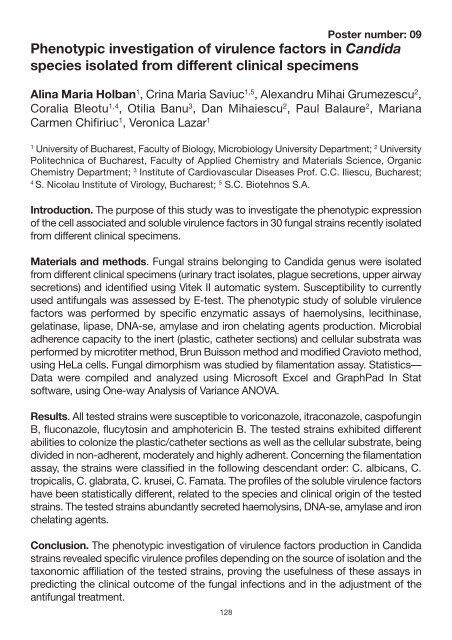Candida Infection Biology – fungal armoury, battlefields ... - FINSysB
Candida Infection Biology – fungal armoury, battlefields ... - FINSysB
Candida Infection Biology – fungal armoury, battlefields ... - FINSysB
You also want an ePaper? Increase the reach of your titles
YUMPU automatically turns print PDFs into web optimized ePapers that Google loves.
Poster number: 09<br />
Phenotypic investigation of virulence factors in <strong>Candida</strong><br />
species isolated from different clinical specimens<br />
Alina Maria Holban 1 , Crina Maria Saviuc 1,5 , Alexandru Mihai Grumezescu 2 ,<br />
Coralia Bleotu 1,4 , Otilia Banu 3 , Dan Mihaiescu 2 , Paul Balaure 2 , Mariana<br />
Carmen Chifiriuc 1 , Veronica Lazar 1<br />
1 University of Bucharest, Faculty of <strong>Biology</strong>, Microbiology University Department; 2 University<br />
Politechnica of Bucharest, Faculty of Applied Chemistry and Materials Science, Organic<br />
Chemistry Department; 3 Institute of Cardiovascular Diseases Prof. C.C. Iliescu, Bucharest;<br />
4 S. Nicolau Institute of Virology, Bucharest; 5 S.C. Biotehnos S.A.<br />
Introduction. The purpose of this study was to investigate the phenotypic expression<br />
of the cell associated and soluble virulence factors in 30 <strong>fungal</strong> strains recently isolated<br />
from different clinical specimens.<br />
Materials and methods. Fungal strains belonging to <strong>Candida</strong> genus were isolated<br />
from different clinical specimens (urinary tract isolates, plague secretions, upper airway<br />
secretions) and identified using Vitek II automatic system. Susceptibility to currently<br />
used anti<strong>fungal</strong>s was assessed by E-test. The phenotypic study of soluble virulence<br />
factors was performed by specific enzymatic assays of haemolysins, lecithinase,<br />
gelatinase, lipase, DNA-se, amylase and iron chelating agents production. Microbial<br />
adherence capacity to the inert (plastic, catheter sections) and cellular substrata was<br />
performed by microtiter method, Brun Buisson method and modified Cravioto method,<br />
using HeLa cells. Fungal dimorphism was studied by filamentation assay. Statistics—<br />
Data were compiled and analyzed using Microsoft Excel and GraphPad In Stat<br />
software, using One-way Analysis of Variance ANOVA.<br />
Results. All tested strains were susceptible to voriconazole, itraconazole, caspofungin<br />
B, fluconazole, flucytosin and amphotericin B. The tested strains exhibited different<br />
abilities to colonize the plastic/catheter sections as well as the cellular substrate, being<br />
divided in non-adherent, moderately and highly adherent. Concerning the filamentation<br />
assay, the strains were classified in the following descendant order: C. albicans, C.<br />
tropicalis, C. glabrata, C. krusei, C. Famata. The profiles of the soluble virulence factors<br />
have been statistically different, related to the species and clinical origin of the tested<br />
strains. The tested strains abundantly secreted haemolysins, DNA-se, amylase and iron<br />
chelating agents.<br />
Conclusion. The phenotypic investigation of virulence factors production in <strong>Candida</strong><br />
strains revealed specific virulence profiles depending on the source of isolation and the<br />
taxonomic affiliation of the tested strains, proving the usefulness of these assays in<br />
predicting the clinical outcome of the <strong>fungal</strong> infections and in the adjustment of the<br />
anti<strong>fungal</strong> treatment.<br />
128


